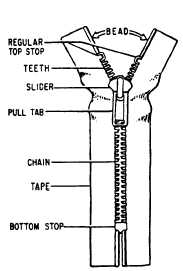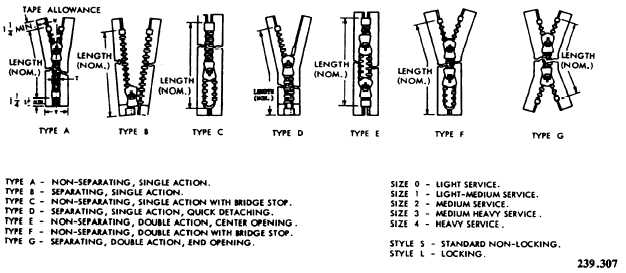Figure 10-18.—Slide fasteners.
figure 10-18. Figure 10-19 shows the parts of an
the slider, which, when moved, displaces teeth at
interlocking fastener.
Interlocking Slide Fastener
Construction
An interlocking slide fastener consists of two
chains of teeth (hollow cones or scoops) facing
each other. When brought together at the proper
angle, each tooth fits within the scoop of the tooth
opposite it.
When closed, the interlocking slide fastener
teeth cannot be parted except through the use of
the proper angle for meshing and unmeshing. The
small clips (stops) at the top and bottom of the
interlocking slide fastener are designed to prevent
the slider from running off the track. Separating-
type slide fasteners do not have a bottom stop,
but are equipped with a pin on one side and
retainer arrangement on the other to allow the two
parts of the slide fastener to separate.
Interlocking Slide
Fastener Operation
Ordinary interlocking slide fasteners are
designed for flat, smooth operation. Both hands
are required for proper functioning. The chains
should be stretched taut with one hand and the
Figure 10-19.—Slide fastener
239.308
parts.
10-16
slider worked (without force) with the other.
When operating an interlocking slide fastener
installed in a garment of soft nappy material, or
lined with wool or fur, do so with care to prevent
the nap or wool from jamming the slider.
Very often grease or oil deposits lodge between
the tiny hollow parts of the teeth and accumulate
dirt and lint. This causes stiff operation of the
slider. A dirty or gummed chain should be cleaned
with an old toothbrush or a pipe cleaner saturated
with Stoddard solvent or other similarly approved
cleaning solvent. After each cleaning, the chain
should be lubricated by applying one drop of oil
or a small amount of graphite between your
thumb and forefinger and running the chain up
and down between your fingers several times.



